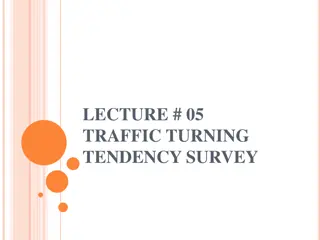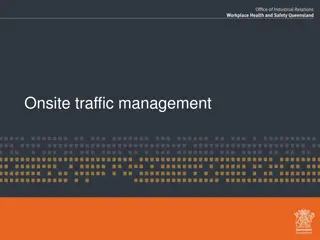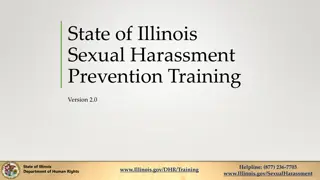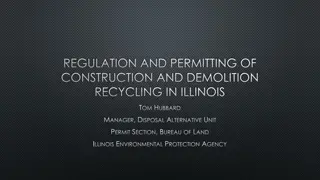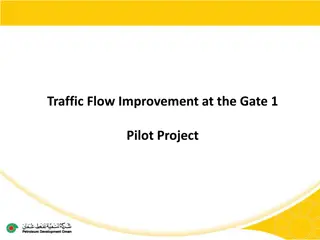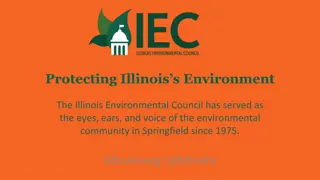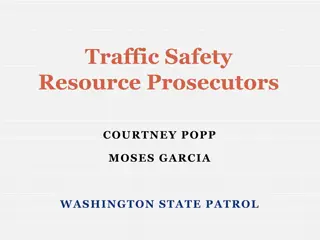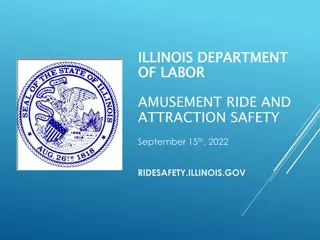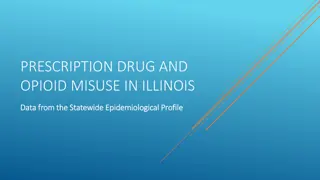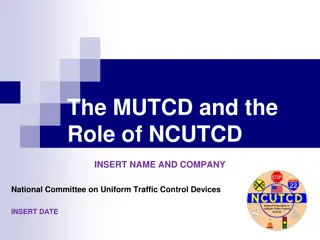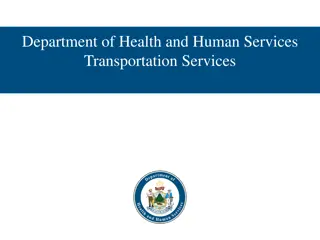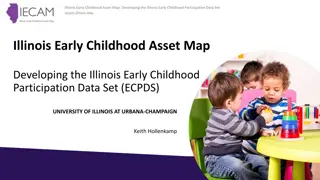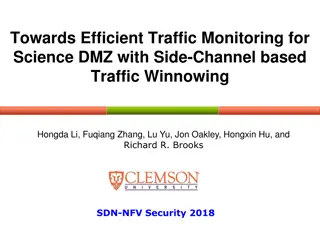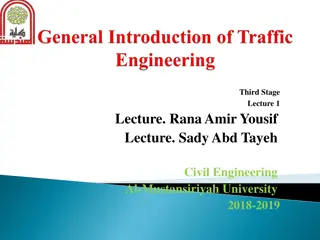Traffic Safety Programs and Performance Measures in Illinois
Presented at the Illinois Traffic Engineering and Safety Conference, John Webber discusses traffic safety programs, challenges outlined in MAP-21, and required performance measures in Illinois based on six years of data. The presentation emphasizes key areas like occupant protection, impaired driving, speed control, and more to reduce crashes, injuries, and fatalities in the state.
Download Presentation

Please find below an Image/Link to download the presentation.
The content on the website is provided AS IS for your information and personal use only. It may not be sold, licensed, or shared on other websites without obtaining consent from the author. Download presentation by click this link. If you encounter any issues during the download, it is possible that the publisher has removed the file from their server.
E N D
Presentation Transcript
Traffic Safety Programs and Safety Culture John Webber, Interim Director Division of Traffic Safety Illinois Department of Transportation Presented at the Illinois Traffic Engineering and Safety Conference in Champaign, Illinois
Moving Ahead for Progress in the 21st Century Act (MAP-21) MAP-21 Challenges: Improve safety Maintain infrastructure condition Reduce traffic congestion Improve system efficiency and freight movement Protect the environment Reduce delays in project delivery Division of Traffic Safety 2 07:11
Illinois Highway Safety Program Areas Occupant Protection Impaired Driving Speed Control Traffic Records Emergency Medical Services Pedestrian/Bicycle Motorcycle Safety Large Truck Police Traffic Services Distracted Driving We are required to identify those programs most effective in reducing crashes, injuries, and deaths, and eligible use of highway safety funds awarded to the State of Illinois
Required Performance Measures in Illinois Based on Six years of Data (2008-2012) Actual Figures 2010 911 13,008 0.86 1.52 0.64 265 Projected Figures 2013 Required Core Measures Total Fatalities Total Serious Injuries Total Fatality Rate Rural Fatality Rate Urban Fatality Rate Unrestrained Occ. Fatalities Impaired Drivers and Motorcyclists Speed Related Fatalities Motorcyclist Fatalities Unhelmeted Motorcyclists Young Drivers involved in Fatal Crashes Pedestrian Fatalities Belt Usage Rate 2008 1,043 13,404 2009 2011 2012 2014 927 918 956 12,636 0.88 1.49 0.67 261 11,945 0.89 1.58 0.65 268 11,562 0.92 1.64 0.67 264 11,081 0.935 1.67 0.68 236 10,608 0.95 1.71 0.68 221 338 356 386 135 97 313 325 130 99 292 438 131 106 278 439 145 110 246 465 148 115 221 492 150 120 195 519 154 124 145 135 90.5 119 112 91.7 146 115 92.6 122 135 92.9 117 138 93.6 114 135 93.7 109 138 95.2
Total Fatality Rate per 100M VMT 1.6 1.42 1.36 1.4 1.26 1.15 1.11 1.1 1.2 0.921.16 1.17 1.16 1 0.99 0.8 0.88 0.86 0.89 0.6 Illinois US 0.4 0.2 0 2006 2007 2008 2009 2010 2011 2012 Division of Traffic Safety at IDOT 5
Total Fatalities by Month During in 2011, 2012, and 2013 120 101 99 99 93 100 93 87 96 90 93 103 90 90 81 82 88 70 79 80 67 80 82 67 79 59 60 57 53 51 54 40 2011 2012 2013 20 0 Jan Feb March April May June July Aug Sep
Total Fatal and Injury Related Crash Data in Illinois (2002-2012) Crash Level Data Person Level Data Serious Injury Crashes Fatal Crashes Injury Crashes Serious Injuries Year Fatalities Injuries 2002 1,273 87,385 14,324 1,420 127,618 19,176 2003 1,308 88,483 13,708 1,454 131,135 18,354 2004 1,224 83,926 13,915 1,355 121,636 18,572 2005 1,233 79,219 13,738 1,363 112,322 18,231 2006 1,136 75,252 13,377 1,254 106,742 17,490 2007 1,126 73,209 12,084 1,248 103,193 15,864 2008 950 67,861 10,415 1,043 94,155 13,401 2009 832 63,439 10,026 911 89,298 13,007 2010 858 63,590 9,807 927 89,038 12,631 2011 835 60,063 9,250 918 84,219 11,938 2012 886 60,255 9,647 956 83,771 12,398
Major Accomplishments Reduction in total Fatalities and Injuries over the last five years High Belt Use (93.7%) Higher Message Awareness of safety belt and alcohol awareness (Over 90%) Improvement in Alcohol-Related Fatalities (lower in absolute number) Establishment of Sustained Enforcement Activities Improvement in crash data reporting (Timeliness, Accessibility, and Data Integration)
Historical Data on Fatality and Historical Data on Fatality and Safety Belt Usage Rates in Illinois Safety Belt Usage Rates in Illinois 2.5 100 90 2.0 80 Back Seat Occupants Primary Belt Law for 70 1.5 60 50 Among 38 Local Click it or Ticket Enforcement 1.0 40 /Minority Focus Ordinances Primary Belt Law Passed Campaign Rural CIOT Primary Initiated 30 0.5 20 10 0.0 0 Fatality Rate Safety Belt Rate Data Source: Observational Survey and FARS
Number of Lives Saved As a Result of Safety Belt Use in Illinois (1985-2012) 10000 6,3626,8277,2637,6558,0218,3658,7009,035 9000 8000 7000 5,848 5,370 6000 4,4344,862 5000 4,030 4000 3000 2000 1000 0 2001 2002 2003 2004 2005 2006 2007 2008 2009 2010 2011 2012 1985-2000
Challenges (Occupant Protection) Lower belted occupant fatalities Lower usage rate among minority drivers Lower usage rate among young male drivers Low usage rate at night among those who fatally injured Lower usage rate among back seat occupants 11
Challenge (Alcohol/Speed) Higher % alcohol-related fatalities Lower rate of state and local agency participation during alcohol campaigns Accurate Problem IDs for the State and local agencies to select high crash locations to patrol High % speed related fatalities Accurate and reasonable coding of alcohol- related and speed related fatalities 12 Division of Traffic Safety
Percent Alcohol Related Fatalities and Percent Belted Occupant Fatalities by Time of Day in Illinois in 2011 80.0% 70.0% 63.0% 58.8% 67.1% 57.0% 60.0% 54.3% 48.5% 50.0% 53.6% 41.6% 40.0% 42.6% 32.9% 30.0% 24.6% 29.9% 20.0% 10.0% 9.3% 8.2% 8.1% 7.1% 0.0% NOON to 3:00PM 3:00PM to 6:00PM 6:00PM to 9:00PM 9:00PM to MIDNIGHT MIDNIGHT to 3:00AM 3:00AM to 6:00AM 6:00AM to 9:00AM 9:00AM to NOON % Belted Occupants % of Alcohol-Related Fatalities
Strategies to Combat Nighttime Belt Use and Alcohol Problems In 2007, improved focus on nighttime enforcement by asking law enforcement agencies to shift half of enforcement activities to nights. Since 2011, all our enforcement grantees were required to conduct enforcement activities at night during major belt and alcohol campaigns. Nighttime hours are 11 PM 6 AM
Major Enforcement Campaigns in Illinois Thanksgiving (Belt) Memorial Day (Belt) Christmas (Alcohol) July 4th (Alcohol) Super Bowl (Belt/Alcohol) Labor Day (Alcohol) St. Patrick's (Belt/Alcohol) Unassigned (locals) Cinco De Mayo (Belt/Alcohol) Unassigned (ISP) The hours and citations for the unassigned enforcement could not be broken down by daytime and nighttime enforcement activities. Unassigned (locals) indicates local enforcement agencies conducted additional enforcement outside the required holiday campaigns.
Challenge Challenge (Non Occupants/Others) (Non Occupants/Others) Pedestrian/Pedal-cycle Motorcycle Riders (Increases in motorcyclist deaths threaten gains made in other areas) Large Truck Others Distracted Driving including cell phone and text messaging 16
Pedestrian Fatalities 160 138 138 135 135 135 140 115 112 120 Projected Figures 100 y = 2.7857x + 118.57 80 60 40 20 0 2008 2009 2010 2011 2012 2013 2014
Total Number of Fatal Crashes Involving Large Trucks and Buses 180 153 160 141 129 140 118 120 105 94 100 Projected Figures 80 y = 11.829x + 81.933 60 40 20 0 2009 2010 2011 2012 2013 2014
Motorcyclist Fatalities 160 y = 4.0714x + 125.57 154 155 150 148 150 145 145 Projected Figures 140 135 135 131 130 130 125 120 115 2008 2009 2010 2011 2012 2013 2014
Plans for 2014 Plans for 2014 Keep up the great participation in Click It or Ticket and Drive Sober or Get Pulled Over. Allocate higher % enforcement Focus on nighttime belt and alcohol enforcement Blend messages on both Focus on high-accident populations/areas Add motorcycle emphasis to impaired and improper licensing crackdowns Add large truck awareness and cooperation
Plan for 2014 (Focusing on Kids) Seat belt and speed enforcement zones near high schools High visibility impaired enforcement mobilizations Strict enforcement of passenger and nighttime restrictions
Contact Information John Webber, Director Division of Traffic Safety at IDOT 1340 North 9th Springfield, IL 62702 Email: John.webber@illinois.gov DTS Evaluation Website: http://www.dot.il.gov/trafficsafety/tsevaluation.html



